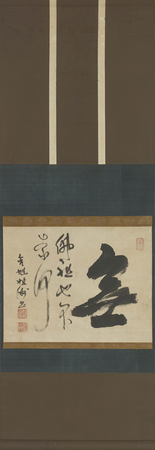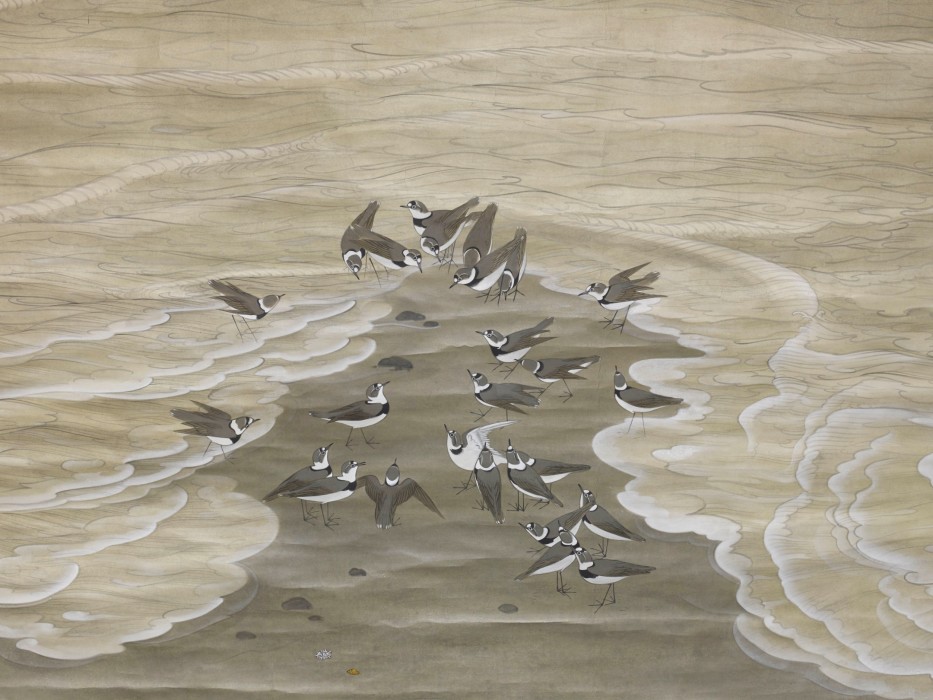Product Description
7111 Keishū Dōrin (1714-1794), the 221st abbot of Tenryū-ji Temple, Kyoto
A paper kakemono (hanging scroll) painted in ink with calligraphy
Signed: Gankyoku Keishū sho (written by Gankyoku Keishū)
Seals:
Upper right: Kaishin (To awaken the mind)
Lower left:
Upper: Keishū Dō-in (Seal of Keishū Dō)
Lower: Iketsu sanjin (Man of a mountain cave, dressed in a Buddhist robe)
Inscription on scroll painting: Mu, Busso ya nanzo motome zu (Nothingness. Buddha and patriarchs demand nothing.)
Inscription on reverse of scroll: Mu (nothingness) Keishū wajo (Priest Keishū)
Japan 18th century Edo period
Dimensions:
Scroll: H. 40¾” x W. 14¼” (103.5cm x 36cm)
Painting: H. 10¼” x W. 13½” (26cm x 34cm)
Keishū Dōrin (1714-1794) 221st Abbot of Tenryū-ji Temple (Rinzai Zen) in Kyoto. Gō (art name): Gankyoku, Raihōken, Iryū Dōjin.
Tenryū-ji, more formally known as Tenryū Shiseizen-ji, is the head temple of the Tenryū branch of Rinzai Zen Buddhism located in Susukinobaba-chō, Ukyō Ward, Kyoto, Japan. The temple was commissioned by Ashikaga Takauji in 1339 to commemorate the death of Emperor Go-Daigo. The first Abbot Musō Soseki (1275-1351) designed the garden which incorporates an extensive rock landscape and a large pond with the backdrop of Arashiyama Mountain. As a temple related to both the Ashikaga family and Emperor Go-Daigo it is held in high esteem and is ranked number one among Kyoto’s so-called Five Mountains (hierarchical order of Rinzai Zen monasteries modelled after the Chinese system). In 1994 it was registered as a UNESCO World Heritage Site and is one of the Historic Monuments of Ancient Kyoto.
Mu is a Japanese word meaning: not, absence, nothing, void (also: not having, without, nonbeing, emptiness). It is a key word in Buddhism, especially in Zen traditions. In modern Japanese it is commonly used in a combination of words as a prefix to indicate the absence of something. The Japanese Rinzai school classifies the Mu Kōan as hosshin (resolve to attain enlightenment) that is appropriate for beginners seeking keshō (Buddha nature).The inscription is a Zen dictum challenging the greatness and peace that Buddha and his disciples may offer and denouncing conventional notions of religion.
Zenga (Zen painting) is a form of teaching: in calligraphy the most common subjects are Zen poems and conundrums. The style of the brushwork is dramatically bold, seemingly impetuous and bluntly immediate in effect. The transition from mind to paper is spontaneous and finished works distil the essence of the Zen experience with simple strokes of the brush. The logic-destroying potential of a Zen Kōan (riddle) becomes visible in the movement of roughly brushed calligraphy.
The kōans consist of anecdotes, conversations with and sayings of the great patriarchs, some legendary and some biographical. They were designed to serve the pupil as a tool in his own religious practices and lead him in the long run to enlightenment.








